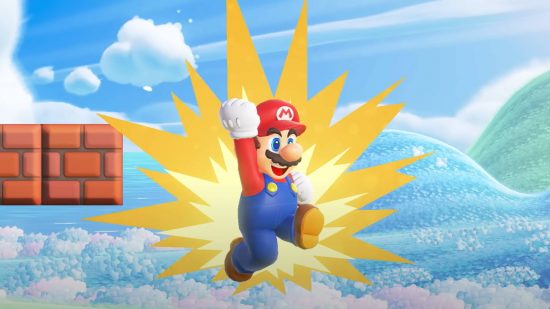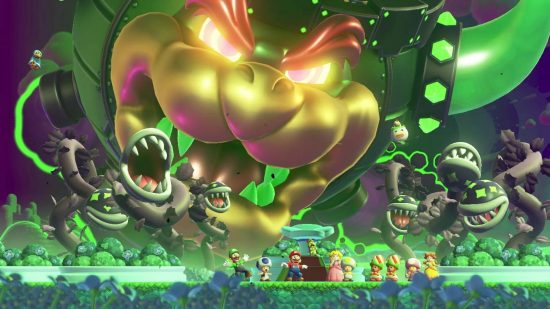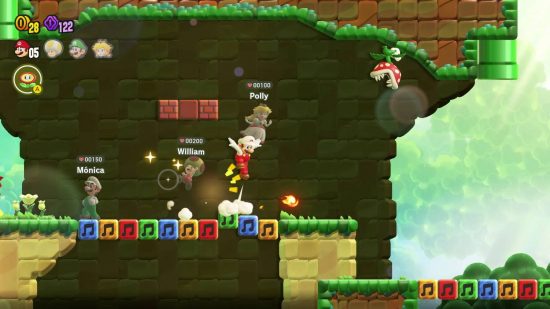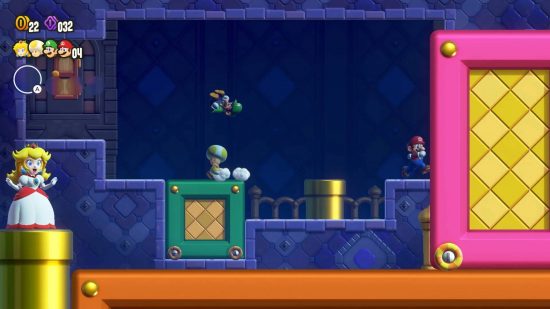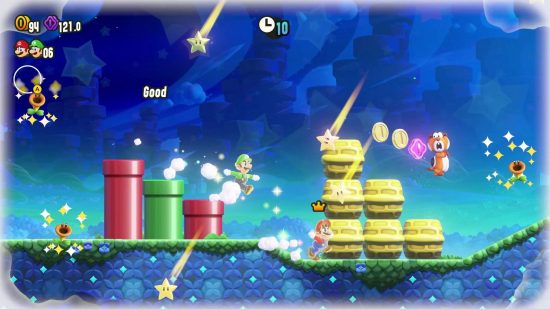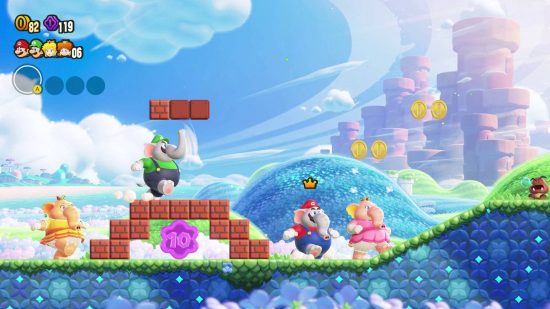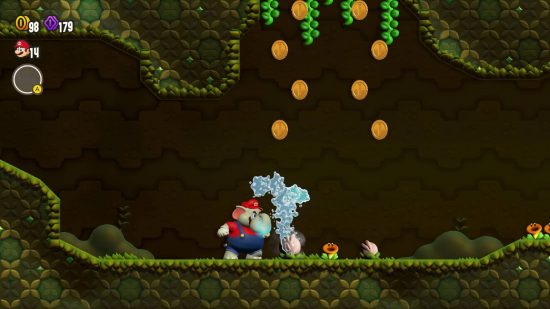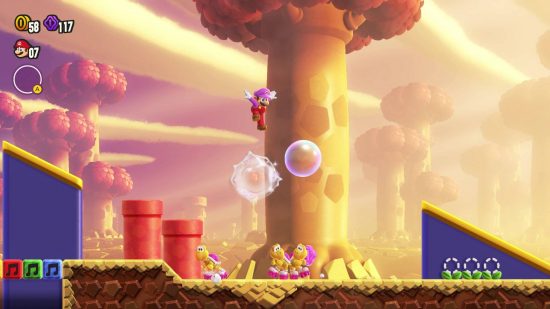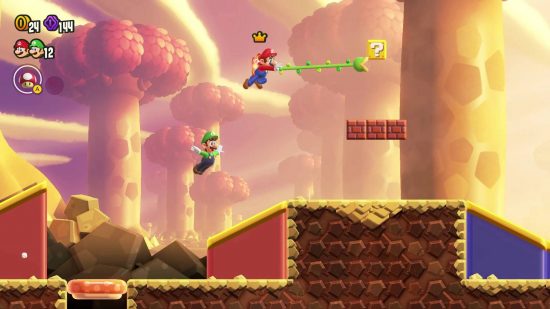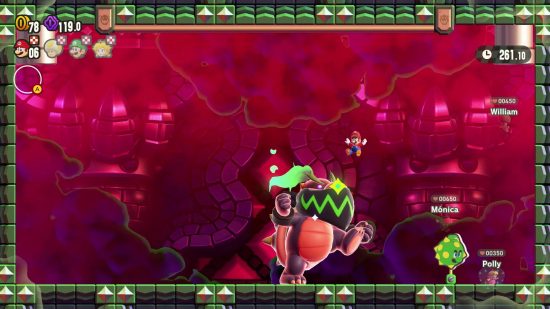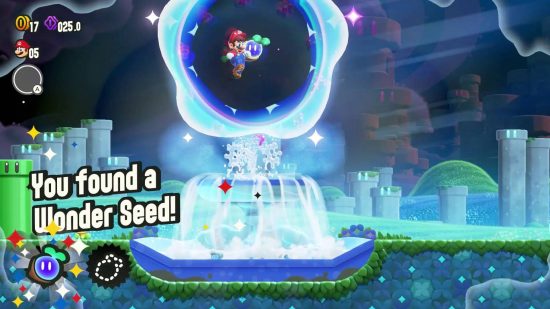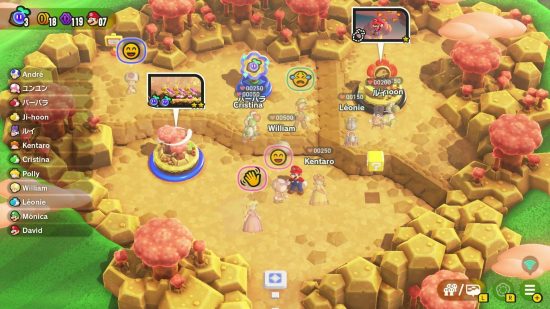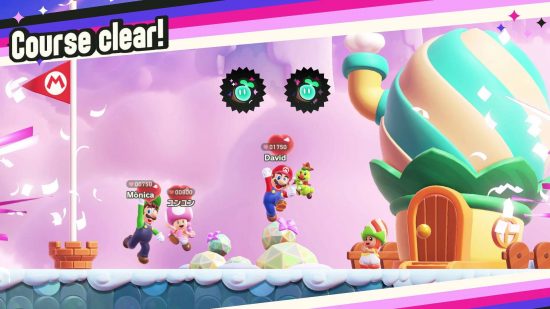Our Verdict
A frankly phenomenal attention to detail, alongside a variety of interesting additions to level design, powers, and the brilliant new badge system, make this Mario’s finest outing in a generation. Super Mario Bros. Wonder is pure Nintendo magic, and an A-Team of veteran Nintendo talent with a fresh injection of younger developers is responsible for the most refreshing, satisfying, and addictive Mario game since Super Mario World. This is the Mario game the Switch deserves and the start of Mario’s new legacy.
When playing exceptional Nintendo games, I think about an intangible element I call ‘Nintendo Magic’ that graces a certain selection of the Big N’s iconic catalog. It’s an additional sprinkle of joy, a light dusting of child-like glee, and the proverbial cherry on top of a delicious package that Nintendo so often delivers. Mario’s Tanooki Tail and the warp whistles. Pulling the Master Sword in Ocarina of Time. The serene calm of 1am in Animal Crossing: New Leaf. Another succinct way to describe these elements, those moments, is wonder.
I’ve been running around in Super Mario Bros. Wonder for a while now. I’ve exhausted almost every secret, every coin, every badge, and have spent hours swinging my trunk around as Elephant Mario. And let me tell you, I’ll be doing it all again with a smile on my face, just to experience this game with more friends. Throughout Super Mario Bros. Wonder’s 10-15 hour campaign (more if you want to find every secret), countless moments of sporadic joy and silly touches elevate the plumber’s latest outing into something special.
It feels especially poignant that Super Mario Bros. Wonder is the first 2D Mario game since the introduction of the Super Mario Maker franchise and The Super Mario Bros. Movie. The influence of both is clear, as there’s an attention to detail in both character animation, alongside the sheer breadth of challenges and ideas. It’s also the first Mario game without Charles Martinet, and in doing so, it feels like a fresh start and a passing of the torch. This is the next generation of Mario, and it’s absolutely right that a 2D Mario game kicks that off.
While it’s been a long wait for Mario’s latest 2D adventure, the patience pays off, as Super Mario Bros. Wonder is the 2D Mario game the Nintendo Switch deserves and a title that every Switch player should own. From the outset of Super Mario Bros. Wonder, both gameplay and visuals feel markedly refreshing alongside the familiar. This feels like a mission statement from Nintendo, proving after Super Mario Maker that it can still surprise and amaze fans. Well, Nintendo did it.
In Wonder, Nintendo swaps the Mushroom Kingdom for the new Flower Kingdom, and with whichever character you choose, you set out on an adventure and meet the adorable little worm fella Prince Florian. Within moments that cranky Koopa Bowser shows up and uses the power of the new Wonder Flower to merge with Prince Florian’s castle, turning into a titanic terror that’s part turtle and part turret.
This happens in a crisp and visually gorgeous cutscene that displays just some of the flair that Wonder exudes in every element. Characters move and express themselves phenomenally thanks to Nintendo’s new animations, and outside of the Mario Movie, the Mushroom Kingdom cast has never seemed so expressive or charming. Alright, it’s not reinventing the wheel, but it’s at least a slight change of pace, a new high-water mark for polish, and a fantastic opportunity to welcome in so many new ideas, settings, and enemies.
Another nice addition is the ability to choose from twelve different characters immediately, with Mario, Luigi, Daisy, Peach, Blue Toad, Yellow Toad, and Toadette all controlling the same, using Mario’s iconic abilities as a blueprint. No, Peach doesn’t hover, but badges and power-ups add the variety you might miss. Next, Nabbit and Yoshi don’t take damage from enemies, but can still fall into pits and don’t benefit from power ups. It’s a great fit for less experienced players, and these characters still control great. No matter which Mushroom Kingdom member you choose, those new animations benefit everyone thanks to an astounding level of detail and endearing designs.
Mario is bursting with charm, but even less beloved characters like the Toads are so cute this time around, while tiny missable moments in movement and interactions all add to the vibe. When you travel through a pipe, the character first peeks their head through, and then characters like Mario and Luigi extend their arms out to quickly grab their hats before the pipe sucks them in. Plus, the Wonder Flowers and their strange secrets hold even more brilliant moments of joy, all presented and animated to the highest standard. It’s also all supported by fantastic sound design, with each jump, whoosh, and patter of feet given its own whimsical accompaniment.
It’s not just animation that impresses, so Mario fans relax, as the controls are one immediate point in the positive camp for Super Mario Bros. Wonder. Movement feels tight but acrobatic, with a restraint that feels reminiscent of Super Mario World, then also well balanced alongside the new badges and their additional powers. Mario and chums move with a nice weight, but younger players can easily try out a helpful badge or change to one of the characters with different abilities. There aren’t any wild changes to Mazza’s base moveset, but the new powers and badges more than make up for things.
Initial trailers showcase a few of the opening chapters, as well as the badges and Wonder Flowers, and while we can’t reveal too much beyond that, just know that the initial burst of creativity doesn’t waver, and Nintendo’s efforts do a good job of propping up the increased difficulty in the back half of the game. With Wonder, Nintendo focuses on younger developers and talent, and it feels like the established team and newer members are responsible for a huge pool of new ideas, and that you can feel as you explore such a wild variety of levels and new enemies.
New badge challenges join the regular stages, where you must wear a specific badge to complete the level, and some of these focused and tightly designed challenges feel ripped straight out of the best examples that Super Mario Maker has to offer. Certain challenges demand pinpoint platforming accuracy or additional badge powers to facilitate some unique acrobatic challenges. The depth of creativity here is unbelievable; I just wish I could return to many of these levels in more ways, much like the purple coin challenges or Cosmic Mario races in Super Mario Galaxy 2.
I adore the level selection here, with an increased focus on depth, much like Mutant Mudds or Abe’s Odyssey, as Mario often hops between different depths. It’s bolstered by platforming that feels sublime to explore and even better to return to with more experience. Levels allow you to use those well-placed ledges to leap and spin at full speed, and the new badge powers work alongside this to create a game I can’t stop playing. I’ve completed Super Mario Bros. Wonder and I want to start from the beginning and run through again.
Levels like World 1’s ‘Scram, Skedaddlers’ are just asking you to blast through at speed, as the new enemy, the skedaddlers, do just that and pelt away at full blast, taunting you into chasing them. In the Petal Isles’ ‘Maw-Maw Mouthful’ the titular new enemy, the maw-maw, is another welcome addition, opening its mouth wide and gobbling up blocks and power-ups alike, forever lost in their guts if you can’t stop them in time.
The new bloomps are a particular joy, and World 4’s ‘Bloomps of the Desert Skies’ uses a similar tactic to Scram, Skedaddlers, instead justin the inflatable Bloomps to push you into bouncing high into the sky. You’d better believe there are secrets waiting for you, melding together just the sheer joy of play with a satisfying reason to do so. Then the Hoopycat is an adorable new spiky foe that jumps when Mario does, bringing even more fun ideas into challenges as they smash through blocks and even platforms.
Honestly, there’s plenty to keep you enthralled over 15 hours and more, so it feels like a nitpick to say I’d love more of an incentive to replay them outside of mopping up a few missed collectibles. There’s also a bevy of secrets hidden in both levels and the overworld. Importantly, Nintendo uses an occasionally simplistic framework with stages and sprinkles each with that extra Nintendo magic, thanks to the new Wonder Flower hidden in every level and the use of hidden purple coins.
At times, in the early handful of stages, I feel like levels are just a case of waiting for the Wonder Flower to arrive, but later stages do a much better job of both hiding the Wonder Flower and creating levels that are exciting in their own right. Each Wonder Flower transformation is an event, and they’re all worth experiencing as even some of the one-and-done powers are a blast to use.
Stages stretch and warp, Mario and the gang transform in multiple wild new ways, and Nintendo constantly surprises you by breaking supposed Mario rules. Alongside the joyous new Wonder Flower theme, every Wonder transformation has me beaming like an 8-year-old kid.
Then, the new Elephant Fruit, Bubble Flower, and Drill Mushroom add more variety and strategy outside of the Wonder Flower moments, and I’m really thankful that almost all levels treat the Wonder Flower as a bonus, not a defining moment simply to hunt out only for you to ignore the rest of the stage. It’s tough to balance an entire game around so many different powers and abilities, but Nintendo is doing a great job, as no power-up feels out of place. Plus, it’s a nice incentive to revisit previous levels with different powers.
Talking of powers, the Elephant Fruit is the star of the show, as the new power-up is front-and-center in many marketing materials. Swinging around as a huge gray Mario is brilliant, and I like both the function and the design of the Elephant Fruit transformation much more than some recent powers such as the Squirrel Suit and even Cat Mario from Super Mario 3D World. Elephant Mario can swing his trunk to break blocks, and you can also grab some water in your trunk and splash it around to revive wilting flowers or extinguish certain enemies.
Using the trunk to water flowers feels akin to blowing flowers in Donkey Kong Country Returns, and it’s used in a similar sense to uncover extra coins and secrets. Wonder doesn’t contain quite the mad depth of collectibles as that monkey masterpiece, but the Mario franchise focuses on a younger audience first. With Wonder, Nintendo is treading a very fine line between approachability and challenge to please all ages.
Then there’s the Bubble Flower, a personal favorite, and not just because I’m a huge Bubble Bobble fan. You can blow bubbles that float through walls, and if they come into contact with enemies they trap them in a bubble and dispose of them. Plus, crafty players can use the bubbles as additional platforms, a really helpful extra ability that, alongside the incredibly satisfying ability to trap enemies like Jake Gyllenhaal, offers up the chance to reach some of those tantalizing little secrets tucked away. I really love this balance of challenge and the added strategy the bubbles offer.
The Drill Mushroom appears much more sparingly, though there are moments where it’s essential. The new power allows you to dig into surfaces drill first (which can damage previously impervious enemies), and then burst out of the ground like the Underminer to unleash twisty wrath on the soft underbellies of koopas and goombas alike. I can see the Drill Mushroom being much more useful in speed runs, allowing skilled players to swiftly skip certain enemies by simply tunneling underneath them. It’s fun but definitely the weakest of the three new powers, and I often feel the more varied abilities of other powers just make them superior.
While the new powers are certainly a blast, they’re supplementary to the star of the show, the new badges and their abilities. The helpful little worm Prince Florian can equip a badge, augmenting your gameplay with new powers, and there are heaps to choose from. The parachute cap lets you float gracefully after jumping from ledges, the crouching high jump gives you a Super Mario 64-inspired ability to duck and then launch into the air, and the dolphin kick gives greater movement speed and combat power when in water. They’re not all about moves either, as the ‘Auto Super Mushroom’ ensures you start each level with a mushroom instead of a dinky version of your character.
Simply put, these badges are the best innovation in modern Mario and one of the smartest additions to the franchise as a whole. Akin to the different abilities of Super Mario Odyssey, but more focused, and importantly, all designed to facilitate the rock-solid platforming that Nintendo is responsible for after decades of experience and fantastic 2D titles. Everyone will have favorites, plus certain levels play better with some badge abilities, and there’s just so much fun in experimenting and finding your own style. I love diving through previous levels with dozens of combinations, combing for secrets, or just trying for better times.
Plus, a few ‘Expert’ badges offer significant rewards if you can wrangle with them. Jet Run gives you a major speed boost, but you run continuously, so it’s a deft balance between knowing the stage and using your reflexes to best take advantage of that increased momentum. Then Invisibility makes you (obviously) invisible, both to enemies and yourself. You can easily avoid your foe’s attacks, but it’s so tricky placing where your character is. It’s so fun to use subtle elements like the clouds or soft exhales of wind around boots landing on the ground to keep an eye on the protagonist’s position.
You earn these badges both through the aforementioned badge challenges, but also from shops around the open world. Each level contains regular purple coins and three large purple coins, and you can spend this currency to buy more badges as you explore the world. It’s a good way to spread them out. Plus, not every badge is available through traditional means. You can also spend purple coins on lives or the fun standees, though we’ll get back to those later in multiplayer.
There isn’t the huge wealth of collectibles or secrets of a title like Donkey Kong Country: Tropical Freeze, but experienced Mushroom Kingdom maniacs have plenty to explore and find. I’m just glad that the collectible purple coins serve a purpose, and you can use them to get rewards in both single and multiplayer. Nintendo isn’t always the best at using collectibles or currencies (cough, Luigi’s Mansion 3), but it feels just right here.
However, I’m not sure thrill-seekers who have completed the likes of Super Meat Boy will find the agonizing platforming tests they want, nor does Super Mario Bros. Wonder reach the maniacal heights of some of Super Mario Maker’s 0.001% completion rate horrors. But I find myself dying fairly often throughout the main campaign, especially while in later levels and uncovering secrets, and it’s always down to my mistakes instead of unfair surprises like many of SMM’s fan creations. Nintendo understands the perfect balance of challenge and our expectations of game design rules, and knows when it can break the latter as well. Trust me, there are some fantastically infuriating challenges waiting for you.
One such moment is the boss battles, as some familiar faces and the power of the Wonder Flower present fresh challenge. Bosses are nicely balanced no matter which power up you have, and difficulty curves nicely. The Wonder Flower adds a welcome sprinkle of variety, and boss designs are awesome, I just wish the renewed focus on new and interesting enemies extended to the cast of bosses. It’s a minor nitpick that perhaps others will dismiss, but standout Mario series moments like Megaleg or Odyssey’s Ruined Dragon prove that Nintendo often crafts its finest boss battles when using fresh characters to facilitate interesting new mechanics.
If you’re after a challenge, though, the run-up to Super Mario Bros. Wonder’s final moments are simply incredible. The early moments of many Mario games are iconic because we see them so often, but it’s always in the crescendo that Nintendo flexes its creative juices the most. The final boss battle, the last world and its levels, and the few hidden secrets scattered around there are a victory lap of Mario Wonder’s finest moments, pulling enemies, Wonder Flower powers, and some amazing elements from previous games to cement a finale that is among Mario’s very best.
I’ve already mentioned the stunning attention to character animation, but it works in tandem with downright stunning visuals. The bright art direction of Wonder clearly communicates levels, and when stretched onto the TV it’s a glorious sight. I repeatedly caught myself gawping at the sparkling clarity of Wonder and the detail hidden in the depths of stages. Plus, it all runs at a silky smooth 60 fps, with those stunning character animations taking full advantage and packing charm into every single frame.
Veteran composer Koji Kondo is back on the staff for Super Mario Bros. Wonder, and sound design is another area where Nintendo is taking incredible care. Characters have different noises to accompany jumps, each power or reaction has a fun sound effect, and even the talking flowers add some comedy to levels. Plus, the fantastic new voice cast adds some new wrinkles to the Mario we love, and the rest of the gang.
The score is full of memorable tracks, and many perfectly capture the renewed level of energy and variety thanks to an increase in new melodies and a greater selection of instruments. There are some more electro-ish songs in here that absolutely slap.
One significant change comes with local multiplayer, as instead of being able to collide with pals and pick them up like in New Super Mario Bros. Wii, here there’s no ‘friendly fire’ as you pass by your pals. Instead, it all feels collaborative. Fall into a pit, and instead of a bubble, you turn into a little ghost, and you must wiggle towards your friends so they can tap you, and bring you back into the world.
This feels like a single-player game first, but local multiplayer is a great way to experience Wonder, even with the chaos of four friends all huddled on a sofa. I think two is the perfect number, as the game doesn’t always do the best job of following different players. Still, it’s so much fun to share this game with pals, and the framerate and visuals never take a hit.
The online multiplayer is a major deviation from previous entries, seemingly focused on supplementing single-player gameplay. Pressing down while crouching has you place a standee, and when online, these work like nearby players in local multiplayer. With online enabled, if you die, you can wiggle your ghost towards a carefully placed standee, giving you an extra chance.
You can also occasionally see the shadows of other players run through levels, revealing how friends and strangers tackle certain challenges. A well-placed standee or a passing spirit occasionally points towards big challenges or secrets, and it’s a really lovely community feature that adds a lot of charm to the campaign. I’d rather this than the stilted and stuttering four-player online multiplayer of Super Mario Maker 2 any day.
In many ways, Super Mario Bros. Wonder fulfills of the promise Nintendo originally made with the New in the New Super Mario Bros. series so long ago. With a new generation of Mario fans on the development staff and an invigorating focus on new ideas, characters, and settings, Wonder feels like the brilliant blueprint for the next thirty years of Mario. Nintendo is delivering an enrapturing Mario masterpiece for a new generation, bolstered by decades of experience and refinement from masters like Takashi Tezuka and Koji Kondo, as well as the cultural phenomenon that is Mario as a brand. I’m a lifelong Mario fanatic, and Wonder is a genuinely heartful reminder of what makes that Nintendo magic so special.
While new powers don’t completely transform the experience, the Wonder Flower and badges add a much-needed kickstart that the Mario series deserves in the modern day. Meanwhile, Nintendo introduces fresh ideas and levels at a breakneck pace, so the campaign is all killer and no filler. Thankfully, incredible multiplayer options, both online and local, work alongside Wonder’s many secrets to offer up plenty of additional hours for experienced and eager fans. Mario’s back, baby, and it feels like he never left.

If this has got you itching to dive through Mario’s history, then be sure to check out our guide to the best Mario games on Switch next.
